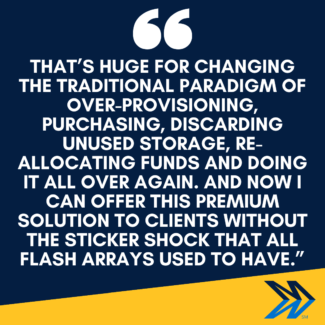March 30, 2021 By: Kim Morgan
In a world where we are obsessed with “faster” and “more”, “as-a-Service” models not only deliver increased speeds for just about everything, but scalable solutions for quickly evolving companies. As a bonus, service providers can delivery massive amounts of usage data and other reporting necessary to streamline operations. These solutions are not JUST for IT, but for all parts of the business – sales, marketing, accounting, and even customer service.
When we think of “as-a-service” products, we typically think of something that is actively used by a number of team members every day: CRMs, cloud contact centers. Even network infrastructure is now available “as-a-service”.
Another member of the ever-expanding “as-a-service” club is data storage. Storage-as-a-Service (STaaS) is poised to become a $100 billion a year industry by 2026. Why? Because in this age of Big Data, big storage is a must-have. And not just big, but smart and nimble, too. Fortunately, what once required a significant up-front investment for hardware and software, not to mention potentially expensive guesswork where capacity was concerned, has been streamlined and simplified. Hybrid storage setups that blend on-prem and cloud-based technology are by far the most common, especially among small and mid-sized organizations.
But not all storage is created equal. That’s certainly true when it comes to the high-end solid-state systems from Pure Storage. A longtime Mindsight partner and a vaunted Leader in Gartner’s 2020 Magic Quadrant, the purveyor of cutting-edge flash storage products has more than 8,000 global customers and aims to simplify “how people consume and interact with data.”
The Problem with Traditional Storage
Almost everyone is familiar with traditional storage as part of a larger disaster recovery scheme. Data is stored on hard drive disks (HDD) and is connected via a LAN/WAN connection. These massive servers are often located at the primary location of the business or organization, and require special conditions – temperature control, moisture control, and limited access.
Buying a server and the necessary software alone can cost up to $5,000. Furthermore, you may need to hire a professional IT company to set it up, which can add another $1,000 to $3,000 to the total. And like desktop computers, servers don’t have a finite lifespan; they typically last for about six years, after which they become obsolete and should be replaced. Rinse. Repeat. All of these costs are capital costs, which, over time, don’t seem to deliver the return on investment (ROI) that the finance or operations arms of the business demand.
What Is Flash Storage And An All-Flash Array?
Flash storage operates very similarly to the RAM on a computer with one distinct difference. Both use computer chips to house electrical charges in cells that signify 1s and 0s in binary code. However, flash storage has an extra transistor gate. This is key, because when the computer, storage array, or other device without this second gate is turned off, the electricity supply is cut off as well. Once the device is rebooted, the RAM chip cannot remember which cells were 1s and which were 0s.
The second transistor gate on a solid state drive (SSD) is able to retain a fragment of that power within the cell. Now, when the device receives power once more, the computer will be able to recognize which cells still have the electrical fragment and register them as 1s and 0s accordingly.
The Pure Storage Difference
“When Flash Storage entered the market, it was a prohibitively expensive, like a Ferrari,” says Mindsight CTO, Eric White. “Now it’s priced like a Honda Accord, but still performs like a sports car. And now everyone else is playing catch up to what Pure has been delivering all along.” Did we mention that this solution was also rated the highest in its category for ability to execute and completeness of vision by Gartner in 2020?
 “Pure is pushing the envelope technologically,” White says. “When it’s time for an upgrade, our clients with Pure are not replacing any drives, just the controller units. It eliminates a ton of downtime, but even more importantly, our clients can take advantage of all the storage they’ve already purchased with their new controller. That’s huge for changing the traditional paradigm of over-provisioning, purchasing, discarding unused storage, re-allocating funds and doing it all over again. And now I can offer this premium solution to clients without the sticker shock that all flash arrays used to have.”
“Pure is pushing the envelope technologically,” White says. “When it’s time for an upgrade, our clients with Pure are not replacing any drives, just the controller units. It eliminates a ton of downtime, but even more importantly, our clients can take advantage of all the storage they’ve already purchased with their new controller. That’s huge for changing the traditional paradigm of over-provisioning, purchasing, discarding unused storage, re-allocating funds and doing it all over again. And now I can offer this premium solution to clients without the sticker shock that all flash arrays used to have.”
Here’s a brief rundown of what Pure-as-a-Service offers and how it works:
- Field-proven flash technology, including FlashArray, FlashBlade and Pure Cloud Block Store
- The company’s trademarked “Evergreen” solution that provides scalability and elasticity without disruptive upgrades and expansions
- On-demand reserve capacity at a discounted rate eliminates under- and over-provisioning
- Cloud-based AI monitoring, dubbed Pure1®, that anticipates capacity needs before they arise
- Modular systems that are quickly deployed and upgraded, resulting in a reduced IT workload
Learn More At Our Chicago Virtual Tech Event
What Pure offers isn’t new, but it’s cutting-edge. Flash storage is on the rise in the storage industry, and proof of its legitimacy is that every major storage developer now has a flash offering. Flash already has a compelling use case for SaaS companies, and it is only a matter of time before flash storage becomes the go-to storage platform for all businesses in every industry. Before that day comes, IT directors should learn the major players and the distinctions between these brands.
Pure and Mindsight are organizing and exclusive virtual event to introduce this solution to our audience. Join our experts on Tuesday, April 13th for a presentation that will cover the basics to consider when undergoing a refresh including:
- Cost – How much will it cost to buy all new hardware, software, and then maintain it? What are the energy costs? When is “end-of-life” and how much does outside support cost?
- Security – Your security is limited by your own team’s expertise and you must both physically and virtually keep your data secure when maintaining it on premise.
- Data – How much will you need to scale your organization’s storage requirements over the next few years?
- Backup and Recovery – Do you have a Backup and Disaster Recovery plan in place? Do you still require external backups?
Our webinar will show you how your organization may be able to simplify storage, reduce costs, and seamlessly upgrade and expand your storage needs without any disruption.
Can’t Make The Event
Our data center experts will meet with your team in exclusive, one-on-one whiteboard sessions – in person or virtually – to outline the solution and what it can do for your business.
Like what you read?
Contact us today to discuss flash storage and Storage-as-a-Service.
About Mindsight
Mindsight, a Chicago IT services provider, is an extension of your team. Our culture is built on transparency and trust, and our team is made up of extraordinary people – the kinds of people you would hire. We have one of the largest expert-level engineering teams delivering the full spectrum of IT services and solutions, from cloud to infrastructure, collaboration to contact center. Our customers rely on our thought leadership, responsiveness, and dedication to solving their toughest technology challenges.
Contact us at GoMindsight.com.
About The Author
Kim Morgan is part of the Marketing Department at Mindsight. Since 2007, she has devoted her career to using digital media to educate and effectively communicate a variety of topics at all levels of expertise. Kim’s favorite part about Mindsight is how team members are encouraged to always be curious, and continue developing not only professionally, but also personally. When not working, she can be found toting her 4 kids around in her sweet sweet minivan while rocking out to hits from the late 90’s and early 2000’s.

